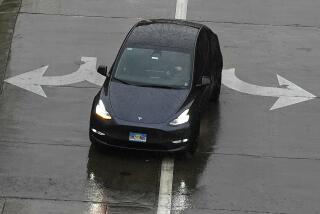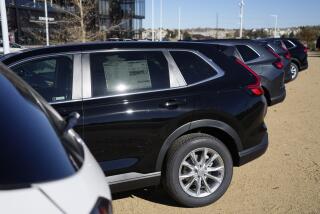Ford to Scale Back Dealership Network
Ford Motor Co. wants to reduce its dealership network in the United States, particularly in major metropolitan areas such as Southern California, to allow the survivors to improve profits as the company battles to reverse a decade of slumping sales.
The plan, outlined to dealers at a meeting in Las Vegas last week, will be “voluntary and collaborative,” Ford spokesman Jim Cain said Monday. Details have not been announced.
For Dearborn, Mich.-based Ford, the problem is too many dealers chasing a shrinking pool of customers for its cars and trucks.
There are 134 Ford dealers in Southern California, selling an average of 900 cars and trucks a year, said one Ford dealer who asked not to be named because he was negotiating a financial deal with Ford and didn’t want to sour the relationship. Japan’s Toyota Motor Corp., by comparison, has 75 dealers covering the same territory, each selling about 4,000 vehicles a year.
Nationwide, Ford dealers sold an average of 696 new vehicles apiece last year while Toyota dealers averaged 1,613, according to the Automotive News Data Center.
Ford has 4,300 U.S. dealers selling the Ford, Lincoln and Mercury brands, down from 4,400 at the end of 2005, and profit for most has plunged in recent years. Ford has said that its average dealership’s profit dropped 10% in the first half of 2006. The company doesn’t provide dollar figures.
“A lot of Ford dealers are losing money,” said Mark Rikess, a Burbank automotive dealership consultant.
Ford won’t say how many dealers it would like to trim from its roster, but the company wants to see reductions in key areas, which could include Chicago, New York and San Francisco, happen “sooner rather than later,” Cain said.
The No. 2 U.S. automaker hasn’t indicated whether it intends to assist dealers in getting out of the business by offering cash incentives or is planning to let attrition do the job, several dealers said Monday.
“If it’s attrition, it could take 10 years,” said Dave Conant, co-owner of Cerritos Ford-Lincoln-Mercury. “If Ford really understands what’s going on, it would get much more involved” and buy out weaker dealers, he said, adding that he would “be really surprised if they did that.”
Burt Boeckmann, president of Galpin Ford in North Hills, the nation’s largest Ford dealership, said he believed the automaker would help thin the herd by putting some of its own cash into consolidation deals.
“They could make substantial inroads in three to five years if they aggressively work at it,” he said. “Otherwise, all this is just lip service.”
Ford isn’t alone in its quest to pare its dealer network. General Motors Corp. and DaimlerChrysler’s Chrysler Group have dealership consolidation plans.
GM Chairman and Chief Executive Rick Wagoner acknowledged in an interview last week that having too many dealers competing with one another in major metropolitan areas remained one of the problems the company must tackle.
“Look at the volume the big three U.S. [auto] companies lost over the last 10 years and realize that their dealer count hasn’t changed much,” said Earl Hesterberg, CEO of Houston-based Group 1 Automotive dealership chain and former head of marketing for Ford’s North American operation.
“Then look at Toyota and Honda, whose dealer counts are pretty constant but whose volume has gone way up,” he said. “They can spend a lot more money on advertising, training, hiring the best people and taking care of their customers.”






